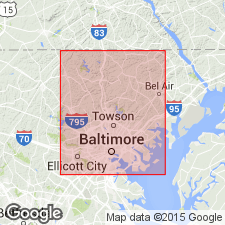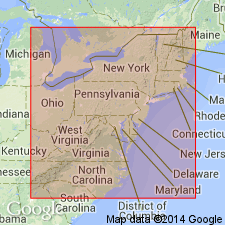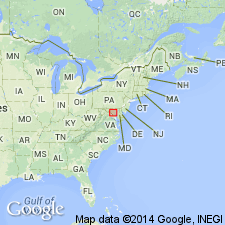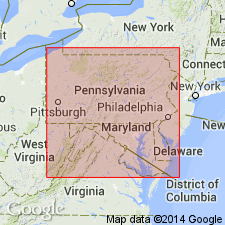
- Usage in publication:
-
- Loch Raven Schist
- Modifications:
-
- Named
- Dominant lithology:
-
- Schist
- AAPG geologic province:
-
- Piedmont-Blue Ridge province
Summary:
Loch Raven Schist of Wissahickon Group here named for Loch Raven Reservoir, Baltimore Co., MD. Unit is predominantly a medium-grained biotite-plagioclase-muscovite-quartz schist with pods of vein quartz. Subdivided into (ascending) Rush Brook and Hydes Marble Members. Thickness ranges to more than 600 m. Overlies Cockeysville Marble; underlies Oella or Piney Run Formations of Wissahickon Group. Age is Cambrian-Ordovician(?).
Source: GNU records (USGS DDS-6; Reston GNULEX).

- Usage in publication:
-
- Loch Raven Schist*
- Modifications:
-
- Revised
- AAPG geologic province:
-
- Piedmont-Blue Ridge province
Summary:
Following Drake (1986, Geological Society of America, Abstracts with Programs, v. 17, no. 7, p. 566), Glenarm Group consists of Setters Formation, Cockeysville Marble, and Loch Raven Schist. The Oella Formation is part of an overlying thrust stack and not part of the Glenarm. Glenarm Group was deposited over Baltimore Gneiss.
Source: GNU records (USGS DDS-6; Reston GNULEX).

- Usage in publication:
-
- Loch Raven Schist
- Modifications:
-
- Overview
- AAPG geologic province:
-
- Piedmont-Blue Ridge province
Summary:
Field and map relations suggest that Loch Raven Schist and Oella Formation are different lithofacies within same stratigraphic interval rather than two distinct stratigraphic units.
Source: GNU records (USGS DDS-6; Reston GNULEX).

- Usage in publication:
-
- Loch Raven Formation
- Modifications:
-
- Revised
- AAPG geologic province:
-
- Piedmont-Blue Ridge province
Summary:
Use of terms Wissahickon Group and Glenarm Supergroup discontinued in MD. Baltimore terrane cover sequence is described using individual formation names. Loch Raven Formation consists of two dominant lithologies: 1) medium to coarse-grained mica schist, interpreted as metapelite and 2) medium-grained gneiss, interpreted as metagraywacke (Oella Formation of Crowley, 1976). Minor amphibolite, micaceous quartzite, and marble also occur locally.
Source: GNU records (USGS DDS-6; Reston GNULEX).

- Usage in publication:
-
- Loch Raven Schist*
- Modifications:
-
- Revised
- Age modified
- AAPG geologic province:
-
- Piedmont-Blue Ridge province
Summary:
Loch Raven Schist is here removed from Glenarm Group because current work shows that Loch Raven Schist is thrust over either Cockeysville Marble, Setters Formation, Baltimore Gneiss, or Laurel Formation. Soldiers Delight Ultramafite (new) lies tectonically between Loch Raven Schist and Sykesville Formation. Age of Loch Raven is here changed to Late Proterozoic and (or) Early Cambrian.
Source: GNU records (USGS DDS-6; Reston GNULEX).
For more information, please contact Nancy Stamm, Geologic Names Committee Secretary.
Asterisk (*) indicates published by U.S. Geological Survey authors.
"No current usage" (†) implies that a name has been abandoned or has fallen into disuse. Former usage and, if known, replacement name given in parentheses ( ).
Slash (/) indicates name conflicts with nomenclatural guidelines (CSN, 1933; ACSN, 1961, 1970; NACSN, 1983, 2005, 2021). May be explained within brackets ([ ]).

